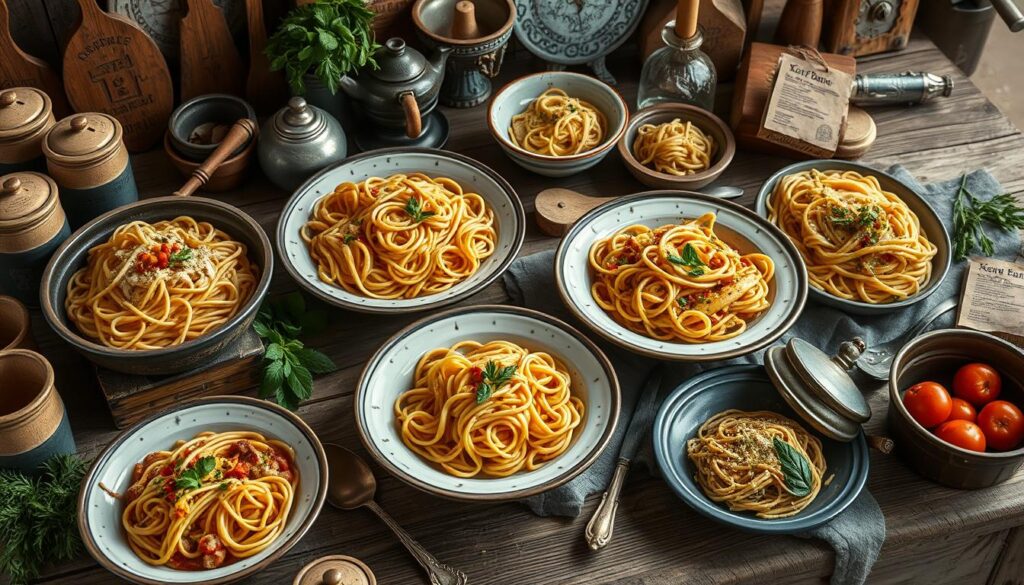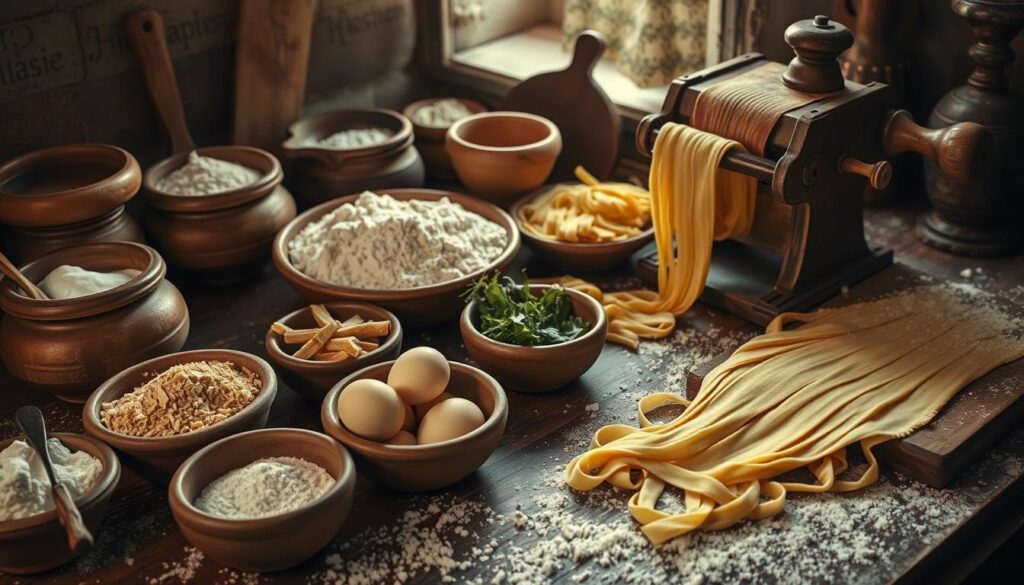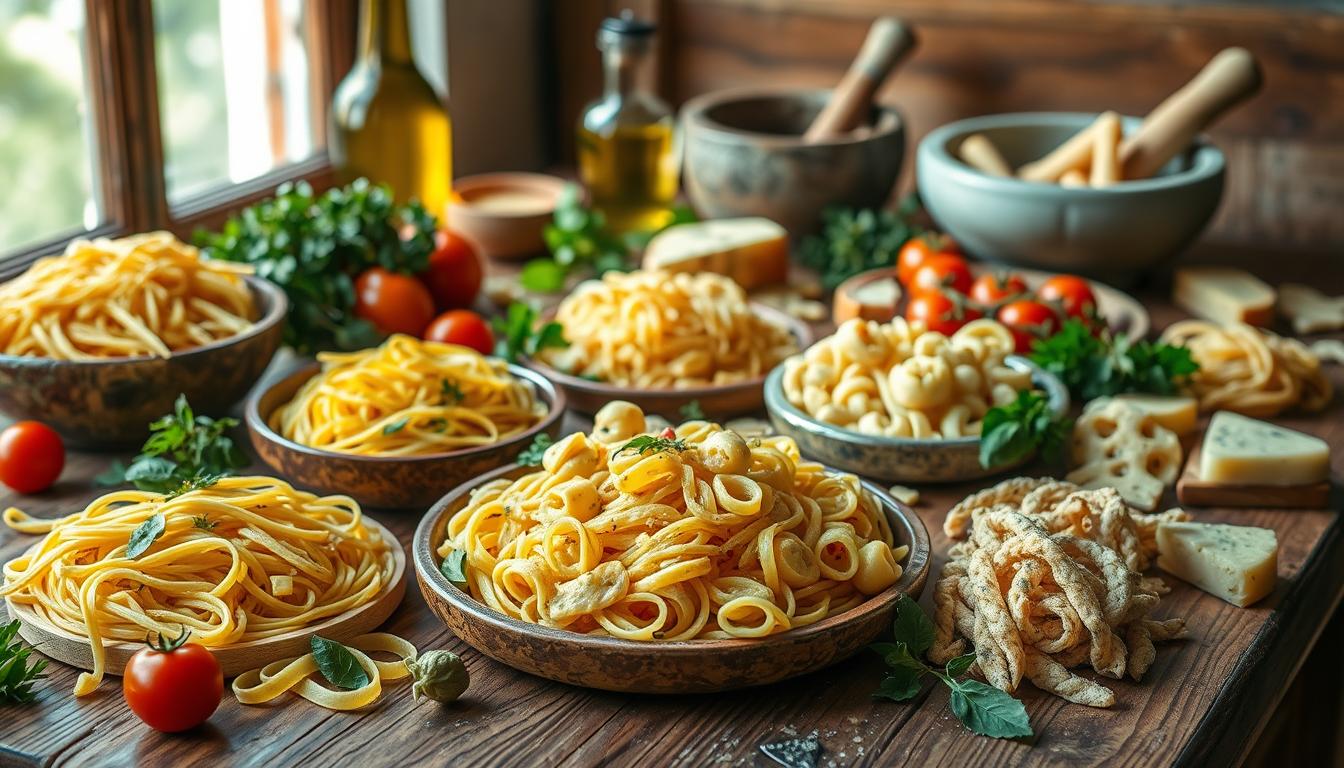Have you ever thought about the history and culture behind pasta? It has a long past, with ancient civilizations all over the world influencing it. From 14th-century Italy’s stuffed pasta to Roman classics like Cacio e Pepe and Amatriciana, each dish has a story to tell.
In this article, we’ll explore pasta’s evolution. We’ll look at its origins and traditional ways of making it. Whether you love pasta or just want to know more about it, join me on this journey through culinary history. Curious about new ideas of Pasta Recipes from History? Here’s everything you need to know!
Table of Contents
Key Takeaways
- Pasta has a rich history dating back thousands of years, with origins in ancient civilizations across the world.
- Classic Italian pasta dishes like Cacio e Pepe and Amatriciana have deep roots in Roman cuisine and tradition.
- Filled pasta creations like ravioli and agnolotti hold a special significance in Italian culinary culture as time-intensive, celebratory dishes.
- Exploring the evolution of pasta-making techniques and ingredients provides a unique window into the culinary heritage of different regions.
- Rediscovering ancient pasta recipes allows us to connect with the flavors and culinary wisdom of the past in our modern kitchens.
The Evolution of Historical Pasta Making
Pasta has been a favorite food around the world for ages. Its history shows how ancient cultures shaped it. The art of making pasta has changed a lot, showing the creativity and importance of this dish.
Early Pasta Production Methods
At first, people made pasta by hand. They rolled and cut dough from durum wheat and water. This hard work led to new ways, like using bronze dies for a special texture.
Traditional Ingredients Through Time
Over time, pasta recipes changed. Durum wheat and water stayed key, but eggs were added for extra flavor. Pasta also picked up local touches, like semolina flour or herbs.
Cultural Significance in Ancient Civilizations
In ancient Rome, pasta was very important. It was a main food for shepherds and country folks. As pasta-making got better, it showed the growing love for this versatile dish.
“Pasta has been a part of Italian culture for centuries, reflecting the ingenuity and culinary heritage of the people.” – Chef Luciano Pavarotti
The story of pasta’s growth is amazing. It shows how tradition and innovation can last. From the first hand-rolled pasta to today’s advanced methods, pasta’s tale is one of culture and perfection.
Origins of Italian Pasta Traditions
Italy’s historical Italian cuisine has deep roots in ancient Rome’s cooking traditions. Four classic Roman pasta dishes – carbonara, cacio e pepe, gricia, and Amatriciana – came from simple, affordable ingredients. These were used by rural communities and shepherds in the area.
The etymology of pasta names often shows the cultural tensions and daily life of people. For example, “strozzapreti,” meaning “priest choker” or “priest strangler,” might hint at the old feud between common folk and the clergy.
- Pasta was known in Italy long before Marco Polo returned from China in 1295. The Etruscans made pasta as early as 400 BCE.
- In the 12th century, Genoese merchants spread pasta across northern Italy. It started in western Sicily.
- By the 17th century, new technology like kneading machines, presses, and dies changed pasta making in Italy.
- The Middle Ages brought durum wheat, making dried pasta possible. It became a key food in Italy then.
The history and cultural importance of historical Italian cuisine are clear in the varied and changing etymology of pasta names. These stories continue to fascinate pasta lovers worldwide.
“Pasta on aristocratic tables was considered a side dish, while for the popular masses it was a complete dish.”
Cacio e Pepe: The Original Roman Pasta
Cacio e Pepe, or “cheese and pepper,” is a classic Roman pasta dish. It’s been loved for centuries, especially by shepherds. They liked it because it didn’t spoil quickly. This shows how ancient pasta dishes and traditional pasta-making techniques are still loved today.
Historical Significance for Shepherds
Shepherds in Rome adored Cacio e Pepe. It needed only three things: pasta, Pecorino Romano cheese, and black pepper. This made it perfect for them, as they worked far from home.
Traditional Preparation Techniques
To make Cacio e Pepe, pasta is cooked until it’s just right. Some of the cooking water is kept aside. Then, hot water is mixed with grated Pecorino Romano cheese to make a creamy sauce. The pasta is tossed with the sauce and lots of black pepper.
Essential Ingredients and Their Origins
The main ingredients are Pecorino Romano cheese and black pepper. Pecorino Romano cheese comes from sheep’s milk and has been made in Rome for ages. The black pepper comes from the Piper nigrum plant, known for its unique taste.
“Cacio e Pepe is a timeless Roman pasta dish that epitomizes the simplicity and elegance of traditional Italian cuisine.”
Pasta Recipes from History: Before the Tomato Era
Before tomatoes arrived in Italy around 1540, pasta dishes used other flavors. Cacio e Pepe and Pasta alla Gricia were favorites in Rome for ages. They showed how simple yet tasty Italian cooking could be, using top-notch ingredients.
Tomatoes weren’t part of early pasta recipes. This shows how clever Italian cooks were in making tasty dishes with what they had.
Pasta is now a catch-all term for many noodle types made from simple dough. This dough is often semolina flour mixed with water. Most noodles include eggs, making them different from other pasta. Western pasta is made from wheat, while Asian noodles might use rice or potato flour.
Pasta has ancient roots. The Chinese made noodles from rice flour around 1700 BC. The Etruscans created spelt noodles like lasagna around 400 BC. The Greeks and Romans also made flat dough into broad noodles, baking them in stone ovens.
| Pasta Milestone | Date | Description |
|---|---|---|
| Earliest Noodle Production | 1700 BC | Chinese prepared noodles from rice flour |
| Etruscan Spelt Noodles | 400 BC | Developed noodles similar to modern lasagna |
| Ancient Greek and Roman Noodles | Unknown | Produced flat dough rolled into broad noodles and baked in stone ovens |
The lack of tomatoes in early pasta recipes shows Italian cooks’ creativity. These pasta recipes from history and historical Italian cuisine show how pasta evolved into a beloved dish.

Pasta alla Gricia: The Second Roman Classic
Pasta alla Gricia is a key Roman pasta dish, evolving from the famous Cacio e Pepe. It highlights the role of guanciale, or cured pork cheek, in ancient Roman cooking.
The Evolution from Cacio e Pepe
Pasta alla Gricia adds richness with guanciale to Cacio e Pepe’s simplicity. While Cacio e Pepe uses only Pecorino Romano cheese and black pepper, Gricia introduces cured pork. This makes the dish more filling and enjoyable.
The Role of Guanciale in Ancient Roman Cuisine
Guanciale, a traditional Italian pork product, was crucial in ancient Roman pasta dishes. It brought a unique flavor and texture to pasta, perfect for cold winter days.
Pasta alla Gricia is among Rome’s four famous pasta recipes, along with Cacio e Pepe, Amatriciana, and Carbonara. The main difference with Carbonara is the use of egg yolks and different cheese.
Mezze Maniche, a short, cylindrical pasta, is the traditional choice for Pasta alla Gricia. However, Penne or Fusilli can also be used for a change. The dish’s simple yet rich ingredients, like pasta, guanciale, Pecorino Romano cheese, and black pepper, make it a beloved ancient pasta dish in historical Italian cuisine.
Renaissance-Era Pasta Preparations
In the Renaissance era, pasta in Italy changed a lot. This change showed the era’s cultural and economic growth. New ingredients and making techniques were introduced, making pasta dishes more complex and varied.
Italy’s growing wealth and trade led to more culinary creativity in pasta making. Pasta went from a simple food to an art form. Chefs and home cooks tried new shapes, sauces, and ways to serve it. This time saw the creation of pasta like conchiglie and farfalle, showing the skill of pasta makers.
But, classic Roman pasta dishes like Cacio e Pepe and Pasta alla Gricia were still loved. They showed the lasting charm of historical Italian cuisine. The Renaissance was a mix of new ideas and old traditions in pasta making.
“The Renaissance was a time of great culinary experimentation, where pasta became a canvas for chefs to showcase their artistry and creativity.”
The Renaissance’s effect on historical Italian cuisine and renaissance-era pasta recipes is still seen today. These dishes are loved worldwide. They keep the magic of Italy’s pasta traditions alive for food lovers.
The Impact of New World Ingredients
Tomatoes arrived in Italy around 1540, changing the historical Italian cuisine and origins of pasta varieties. At first, they were yellow or gold. Tomatoes added a new twist to Italian dishes, like Pasta all’Amatriciana, starting a big change in pasta traditions.
Introduction of Tomatoes to Italian Cuisine
Tomatoes, from the New World, came to Italy in the 16th century. This big change mixed historical Italian cuisine with origins of pasta varieties from the Americas. It led to famous Italian pasta dishes loved all over the world today.
Evolution of Traditional Recipes
Tomatoes changed traditional Italian pasta recipes in a big way. Dishes like Pasta all’Amatriciana, with guanciale, pecorino cheese, and tomatoes, show the mix of old and new. This mix defined a key time in historical Italian cuisine and origins of pasta varieties.
| Ingredient | Historical Significance | Impact on Pasta Recipes |
|---|---|---|
| Tomatoes | Introduced to Italy from the Americas in the 16th century | Revolutionized traditional pasta dishes, leading to the creation of new recipes like Pasta all’Amatriciana |
| Guanciale | Cured pork cheek, a traditional ingredient in Roman cuisine | Became a key component in the evolution of Pasta all’Amatriciana, blending Old World and New World flavors |
| Pecorino Cheese | A staple in Italian cooking, with roots dating back to ancient Roman times | Remained an integral ingredient in Pasta all’Amatriciana, contributing to the dish’s signature taste |
“The introduction of tomatoes to Italy marked a pivotal moment in the evolution of historical Italian cuisine and the origins of pasta varieties.”
Medieval Pasta Making Techniques
In the medieval era, making pasta in Italy was a detailed process. People used hand-rolling and cutting to create pasta. This method is still used today. Pasta was dried to keep it fresh for a long time, as it was a luxury item in Europe.
Medieval pasta recipes used local ingredients. This showed the tastes and traditions of each region. For example, in Tuscany, Pici and Pappardelle were popular. They were often served with meat sauces.
In Naples, making spaghetti was key. The climate was perfect for drying the dough. The Arabs introduced the method of drying stringy dough, which helped preserve food during long journeys.
Throughout the Middle Ages, pasta-making got better. The Kingdom of Sicily became a big producer of spaghetti in the early twelfth century. Despite wars, plagues, and famines, pasta remained a staple. This was thanks to durum wheat, which was widely available.
Now, you can learn about medieval pasta-making in Florence. Pasta-making courses and culinary tours let visitors see the traditional techniques. They offer a peek into the rich history and cultural heritage of pasta.
| Historical Pasta Fact | Supporting Evidence |
|---|---|
| Ancient Etruscans in Tuscany potentially made pasta-like foods | Supported by archaeological finds and references to wheat cultivation |
| Pasta production in Medieval Italy gained prominence | Pasta dishes mentioned in medieval manuscripts, noted for long shelf life |
| Pasta recipes documented in Renaissance Florence | By renowned chefs like Bartolomeo Scappi and Cristoforo di Messisbugo |
| The Medici family influenced pasta-making and Italian culinary traditions | Caterina de’ Medici contributed to the evolution of pasta-making |

“Pasta was the first recorded form of food in the eastern Mediterranean and was known in ancient Greece as laganon or lasanon.”
Ancient Pasta Storage and Preservation Methods
Understanding traditional pasta-making is key to historical Italian cuisine. A vital part often overlooked is how pasta was stored and preserved. These ancient methods helped pasta become a staple in Italy and beyond.
Traditional Drying Techniques
Ancient Italian pasta makers used air-drying to keep pasta fresh. They hung pasta over rods or laid it on racks. This allowed air to dry the dough, making it last longer.
This method was perfect for travelers, shepherds, and those in remote areas. It made pasta a convenient food to store.
Storage Vessels and Methods
Clay pots and wooden barrels were used to store pasta. These vessels protected the pasta from moisture and pests. This kept the pasta’s quality and texture intact, even after long storage.
The development of these methods was crucial. It helped pasta become a beloved food in Italian cuisine.
FAQ
What is the history of pasta dishes?
Pasta has a long history, starting 3,500 years ago in China. It then spread to Europe, Africa, and the Middle East. In Rome, classic dishes like Cacio e Pepe and Pasta alla Gricia were born. These dishes use long noodles or short tube pastas like rigatoni.
How did early pasta production evolve?
At first, pasta was made by hand-rolling and cutting dough. It was made from durum wheat, water, and sometimes eggs. Later, making pasta became more complex, using bronze dies for a rough texture that holds sauce well.
What is the cultural significance of pasta in ancient civilizations?
In ancient Rome, pasta was a staple for shepherds and rural people. Its making evolved from simple hand-rolling to using bronze dies for a better texture. This made sauces stick better to the pasta.
What are the origins of traditional Italian pasta dishes?
The four main Roman pasta dishes are carbonara, cacio e pepe, gricia, and Amatriciana. They came from simple ingredients used by rural people and shepherds. The names of these dishes often tell interesting stories, like “strozzapreti” meaning “priest choker.”
What is the history of Cacio e Pepe?
Cacio e Pepe, or “cheese and pepper,” is one of Rome’s oldest pasta dishes. It was loved by shepherds because it didn’t spoil easily. It’s made with just three things: pasta, Pecorino Romano cheese, and black pepper.
To make it, pasta is cooked al dente, then water is reserved. Hot water is whisked into grated cheese to make the sauce. The pasta and pepper are then tossed together.
How did pasta dishes evolve before the introduction of tomatoes?
Before tomatoes came to Italy in 1540, pasta dishes used other flavors. Cacio e Pepe and Pasta alla Gricia were favorites for centuries. They showed how Italian cooking could be simple yet flavorful with just a few ingredients.
What is the history of Pasta alla Gricia?
Pasta alla Gricia is a Roman dish that evolved from Cacio e Pepe. It added guanciale, or cured pork cheek, for more flavor. This made the dish richer and perfect for cold winter nights.
How did pasta preparations change during the Renaissance?
During the Renaissance, pasta making got more complex as Italy grew richer. New ingredients and techniques were introduced. This led to more varied and complex pasta dishes, but traditional Roman dishes remained popular too.
How did the introduction of tomatoes impact Italian pasta cuisine?
Tomatoes, known as “pomodoro,” changed pasta cuisine in Italy around 1540. They were first yellow or gold. Tomatoes led to new dishes like Pasta all’Amatriciana, blending old traditions with new ingredients.
What were the medieval pasta-making techniques?
Medieval pasta making was done by hand-rolling and cutting. Pasta was dried to keep it for long periods. It was a luxury in many parts of Europe then.
Recipes from this time used local ingredients and showed regional tastes. These methods are still used today in making pasta.
How did ancient civilizations store and preserve pasta?
Ancient people dried pasta to keep it for a long time. They used racks or rods to dry it. This method helped keep pasta fresh for travelers and shepherds.
They stored pasta in clay pots and wooden barrels. These methods helped pasta become popular across Italy and beyond.

